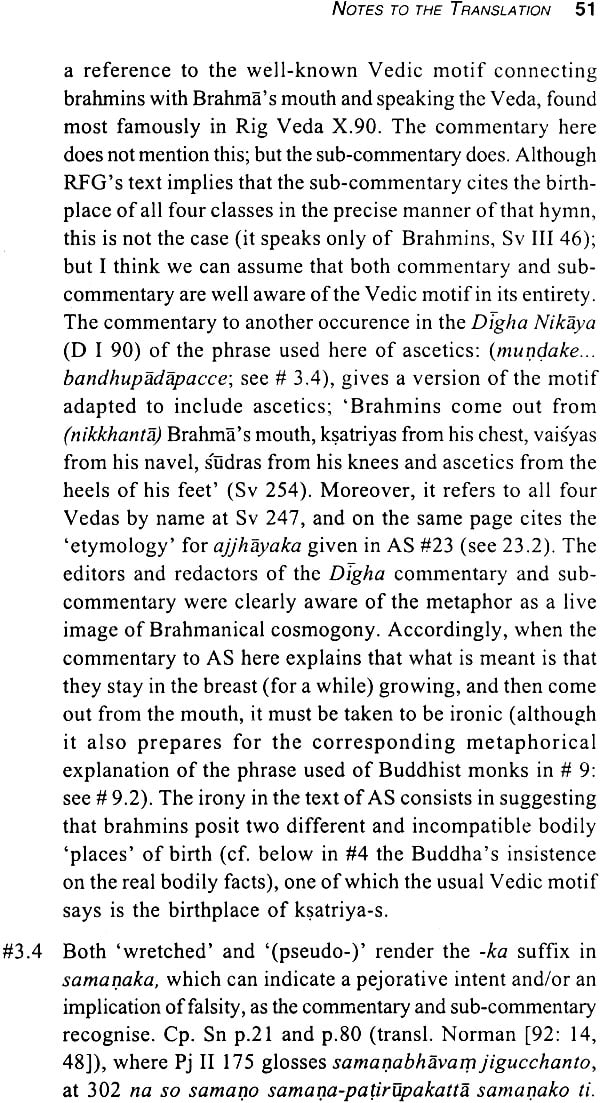
AGGANNA SUTTA - The Discourse on What is Primary
Book Specification
| Item Code: | IDE124 |
| Author: | Steven Collins |
| Publisher: | SAHITYA AKADEMI, DELHI |
| Language: | An Annotated Translation from Pali |
| Edition: | 2001 |
| ISBN: | 8126012986 |
| Pages: | 101 |
| Cover: | Paperback |
| Other Details | 8.5" X 5.5" |
| Weight | 150 gm |
Book Description
Agganna Sutta, part of Digha Nikaya, is one of the early texts of Buddhism. It has seen a couple of English translations, if not more, since the 19th century. It was even referred to as the Buddhist 'Book of Genesis'. Each translation presents the original text in different shade. The present translation by Steven Collins focuses its attention on the hidden realities of the text. He is also quite sensitive to the sheer poetic energy of the text; he has managed to capture the beauty of the cosmic imagery of the original without resorting to the easily available 'poetic' mode of translation. This text can be read as one of the important achievements of ancient Indian literature, where the binary opposition between literature and philosophical narrative collapses.
STEVEN COLLONS, the translator, teaches at the university of Chicago, USA.
This translation of the Pali Agganna, from the Digha Nikaya, was originally published as an article in the Journal of Indian Philosophy, Vol. 121 (4) 1993, pp. 301- 93, under the title The Discourse on What is Primary (Agganna Sutta): An Annotated Translation. It is reprinted here by kind permission of Kluwer Academic Publisher. I have made no changes, although further reading of the Pali text with students at the University of Chicago has convinced me that there is much more to be said about it. The general analytical framework sketched in the General Introduction has been developed in Collins (98).I am very grateful to late Professor D.R. Nagarj for suggesting that this work should be published in India in a book from. I hope that this book will stimulate further study and discussion in India of the early Buddhist texts in Pali, and of the attitude towards social hierarchy and morality which is attributed to the Buddha in this and other texts.
| General Introduction | 1 | ||
| I. | Some Remarks on the Context(s) of AS | 1 | |
| i. | In world history: agrarian social order | 2 | |
| ii. | In early Indian history: towns and small-scale polities | 6 | |
| iii. | In early Indian culture debate: competing hierarchical models | 9 | |
| II. | Some Remarks on the Text of AS | 11 | |
| i. | Is the test as we have it a clumsy patch work? | 11 | |
| ii. | What is the nature of the 'satire' in AS? | 12 | |
| iii. | AS in relation to other early texts | 16 | |
| iv. | Notes on the status of my interpretation | 21 | |
| III. | The Story of Origins, Monastic Life and Ideals, and the Vinaya | 24 | |
| i. | Individual verbal reminiscences of the Monastic code (Vinaya) | 24 | |
| ii. | The five impossible things | 25 | |
| iii. | 'Making a store': the Fall of Mankind and Vinaya Infractions | 26 | |
| IV. | The Structure of AS and Keywords | 30 | |
| Notes to the Introduction | 33 | ||
| End Notes | 34 | ||
| Translation | 39 | ||
| Introduction | |||
| The Discourse on What is Primary | |||
| Notes to the Translation | 50 | ||
| Abbreviations | 83 | ||
| Appendix 1: On the Word Mahasammata | 84 | ||
| Appendix 2: Is there a 'Social Contract' in AS? | 93 | ||
| Bibliography | 97 | ||






